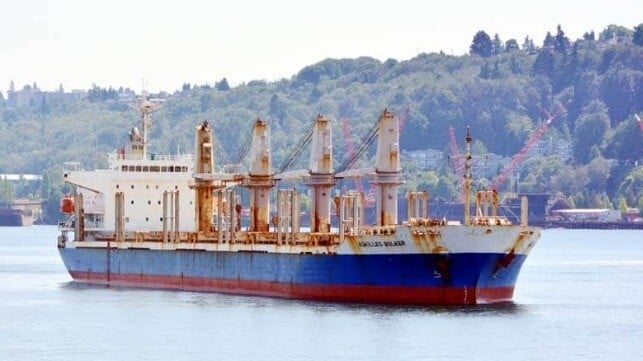Poor Welding Caused Bulker to Lose its Rudder and Nearly Run Aground

Investigators at New Zealand’s Transport Accident Investigation Commission (TAIC) released their final report on a July 2023 incident with the Achilles Bulker, reporting that poor welding during maintenance led to a series of failures that ultimately saw the vessel lose its rudder and nearly run aground. Divers had discovered the unusual circumstances reporting the vessel had lost its rudder, and now the investigators have pieced together the likely scenario with a warning to both shipyards and shipowners, operators, insurance providers, and classification societies.
The Achilles Bulker, 32,729 dwt and 580 feet (177 meters) in length, had gotten underway as normal on July 24, 2023, fully loaded and departing the Port of Tauranga, New Zealand, with a pilot aboard. The vessel, which was built in 2003, was managed from Taiwan. On board was a load of logs bound for China.
Shortly after clearing Tauranga Harbor, the bridge team reported the vessel was steering erratically and veering off course. As they attempted to steer it back on course, the ship shuddered, and there was a loud bang. The pilot took control of navigation, trying to get the vessel on course when a second, louder bang was heard. Unable to get the vessel back into the channel, the pilot struggled to slow the ship and ordered the crew to immediately drop both anchors.
Thirty minutes later, they reported the ship was stopped outside the channel. It had narrowly avoided grounding, with the reports indicating there was less than one meter of clearance under the keel. Divers inspecting the vessel were surprised to find its rudder was gone. They were able to recover the rudder two days later from the sea floor.
Inspectors were surprised to see that the rudder pintle was missing, and they concluded that it left the bottom of the rudder unsupported and allowed excess movement in the rudder system. They said the rudder broke off when the rudder palm fractured on both sides of the stock.
Reviewing the vessel’s records, they found that two years earlier, in 2021, during a routine dry docking, the rudder pintle assembly had been removed and later reinstalled.
“It is virtually certain that the way the rudder pintle assembly was reinstalled did not ensure that the pintle would remain in place during normal shipboard operations,” TAIC writes in its report. “The way the rudder pintle was reinstalled meant that components used to secure the pintle in place failed, allowing the pintle to drop from the bottom of the rudder.”
TAIC concluded that the securing parts installed had weak, porous welds. After the ship was back in service, the welds failed due to vibration. The nut that retained the pintle as part of the assembly unwound itself, and at some undetermined point, the pintle dropped unnoticed from the casting and sank. At this point, TAIC concludes the rudder began experiencing unintended movement, adding to the stresses. Moving side-to-side and fore and aft, the forces were beyond the designed strength of the coupling plate (palm) at the top that joined the rudder to the solid shaft (stock) that connected to the internal steering mechanism. Fatigue cracks grew until the rudder finally fell off.
The vessel was repaired and returned to service. TAIC is now issuing a warning and calling for robust quality assurance procedures at the shipyard for the installation of a rudder pintle. It also notified the Maritime Safety Administration of China and says it will work with the International Maritime Organization to promote enhanced global standards for quality assurance of rudder systems during installation, maintenance, and repairs.
Top photo of the Achilles Bulker in 2022 by Joe Mabel -- CC BY-SA 4.0 license
